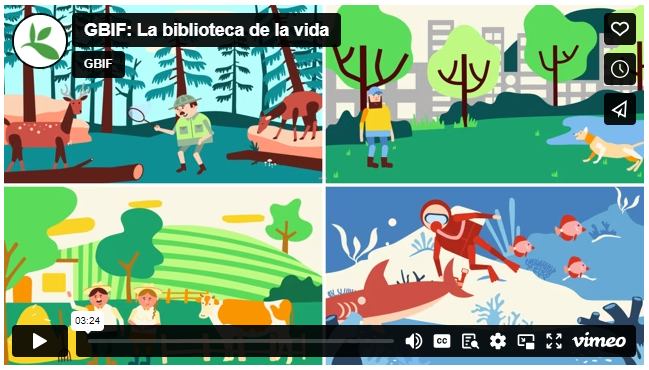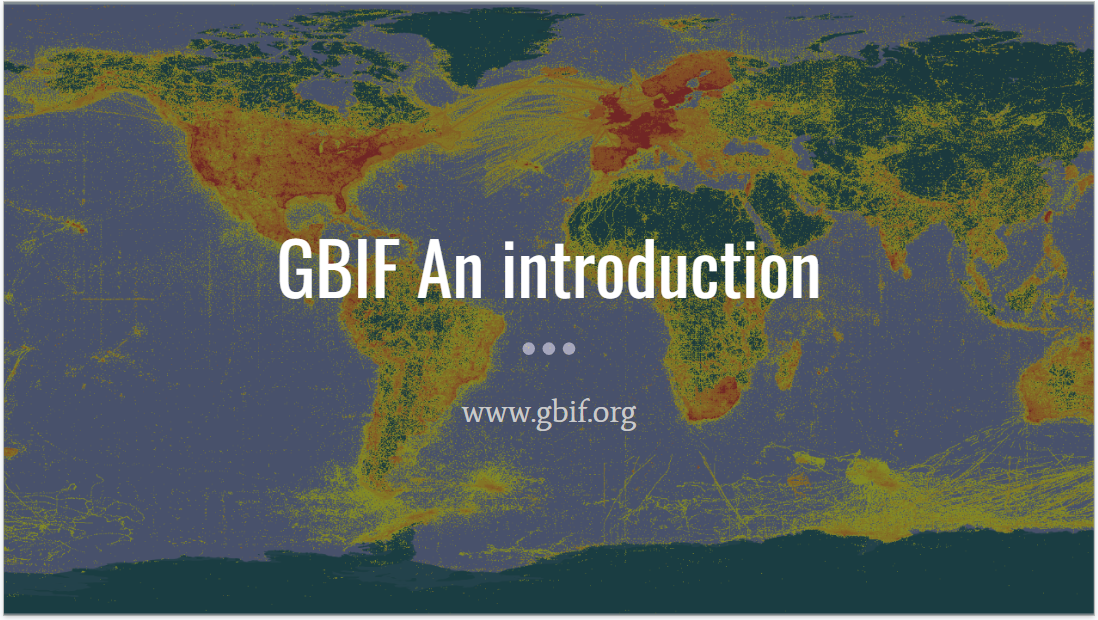Introduction to GBIF
Overview
Teaching: 45 min
Exercises: 30 minQuestions
What is GBIF?
How is GBIF organized
The GBIF portal
Objectives
Understand how GBIF works.
Understand how GBIF is organized.
Basic understanding of the GBIF portal
GBIF—the Global Biodiversity Information Facility—is an international network and data infrastructure funded by the world’s governments and aimed at providing anyone, anywhere, open access to data about all types of life on Earth.
About
The Global Biodiversity Information Facility (GBIF) is an international network of country and organizational Participants that exists to enable free and open access to biodiversity data from all sources and to support biodiversity science, environmental research, and evidence based decision-making. GBIF operates as a federated system of distributed data publishing efforts, coordinated through a global informatics infrastructure and collaborative network. In this module, you will learn more about GBIF.
GBIF introduction movie
In this video (03:23) you will learn about GBIF through animation. It is a co-production of SiB Colombia and GBIF Spain, both GBIF national nodes, with co-funding from GBIF Spain and Instituto de Investigación de Recursos Biológicos Alexander von Humboldt (IAvH). The video is in Spanish, but subtitles are available.
What is GBIF video
In this video (07:55), Tim Hirsch, Deputy Director of the GBIF Secretariat, provides you with an overview of GBIF.
GBIF Overview
GBIF updates a set of overview slides with key information on a quarterly basis. The deck provides an overview of the network status, data use, access and publication, and the latest news and announcements.
Presentation
Exercises 1: Investigate how your country/organization is represented in GBIF
The GBIF website has pages dedicated to countries/economies, including for countries/economies that do not yet participate in GBIF. You can use the search box on the homepage to look up a country/organization.
- The tabs on these pages provide a general description of:
- data available about the biodiversity of the country
- data published by your country/organization,
- the participation of the country/organization
- other relevant information on the use of data by researchers in the country/organization.
- Look up your country on the GBIF website.
- Is a list of introduced and invasive alien species available for your country?
- How well does the information available on GBIF reflect what you know about the biodiversity of your country?
- Do you see publications from/about your country?
- Download the Croatia Activity report
Solution
- Find Croatia on this map
- [Global Register of Introduced and Invasive Species- Croatia] (https://www.gbif.org/dataset/f82a4f7f-6f84-4b58-82e6-6b41ec9a1f49)
- Note your idea about this
- publications
- activity report
Exercises 2: Downloading data from GBIF
The GBIF website has pages dedicated to data retrieval and downloading.
- Find and download this occurrence only dataset from GBIF: “Tipuloidea of Martinique - 2016-2018”
- Find and download this sampling event dataset from GBIF: “Meetnetten.be - Chorus counts for Amphibia in Flanders, Belgium’
- Find and investigate this checklist on GBIF: https://www.gbif.org/dataset/fd004d9a-2ea4-4244-bb60-0df508d20a15
How many times is this dataset cited?
How many occurrences are in this dataset?
Are all the occurrences georeferenced?
What is the licence on the dataset?
Which sampling method was used to collect the specimen?
Is there any media vailable about this dataset?
How should you cite this dataset?
What is the DOI of this dataset?
Solution
url
5
282
all georeferenced Check issues and flags
282 occurrences where ‘Licence’ equals: CC0 1.0
During the 2018 expedition, the main collecting methods were coloured pan traps and sweep nets. In 2016-2017, also Malaise traps were in operation.
Mederos J, Pollet M, Oosterbroek P, Brosens D (2023). Tipuloidea of Martinique - 2016-2018. Version 1.10. Research Institute for Nature and Forest (INBO). Occurrence dataset https://doi.org/10.15468/s8h9pg accessed via GBIF.org on 2024-02-12.
https://doi.org/10.15468/s8h9pgurl
33
710
all georeferenced Check issues and flags
710 occurrences where ‘Licence’ equals: CC0 1.0
url Piesschaert F, Speybroeck J, Brosens D, Westra T, Desmet P, Ledegen H, Van de Poel S, Pollet M (2023). Meetnetten.be - Chorus counts for Amphibia in Flanders, Belgium. Version 1.17. Research Institute for Nature and Forest (INBO). Sampling event dataset https://doi.org/10.15468/d4bu8j accessed via GBIF.org on 2024-02-12. https://doi.org/10.15468/d4bu8jurl
0
0 This is a checklist
nothing georeferenced, but the target area of this checklists is Flanders, Belgium
*CC0 1.0
No
Branquart E, Adriaens T, Desmet P, Devisscher S, D’hondt B, Denys L, Dumortier A, Latli A, Oldoni D, Packet J, Scheers K, Vanderhoeven S, Vermeersch X, Willeput R (2023). RIPARIAS target species list. Version 1.47. Research Institute for Nature and Forest (INBO). Checklist dataset https://doi.org/10.15468/p4ugqr accessed via GBIF.org on 2024-02-12. https://doi.org/10.15468/p4ugqr
Key Points
The GBIF portal is the place to find biodiversity data


